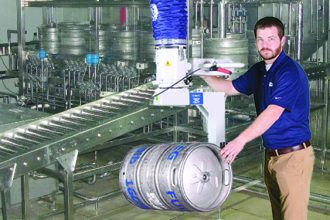10 Ergonomic Pitfalls in Material Handling—And How to Fix Them

Ergonomics is a cornerstone of safety, efficiency, and productivity in material handling. Yet, it’s often overlooked—despite the fact that musculoskeletal disorders account for over one-third of all workplace injuries, according to the Bureau of Labor Statistics. Poor ergonomic practices not only lead to worker injuries, but also contribute to equipment damage and costly workflow disruptions.
Below, we outline 10 ergonomic pitfalls and key challenges that hinder ergonomic success and present solutions to overcome them.
Force Demands
Workers often face excessive force requirements when moving heavy or awkward loads, leading to strain, fatigue, and injuries. Compounding the problem, high start forces and rolling resistance—often caused by improper wheel selection or poor maintenance—further escalate these risks.
Solution: Opt for low-resistance wheels and ergonomic equipment designed to minimize force demands, promoting safety and efficiency. Utilizing larger diameter wheels with hard treads, such as those made from steel or nylon, can significantly reduce rolling resistance. However, it is important to consider the condition of the floor and the potential need for floor protection.
Inconsistent Floor Surfaces and Obstacles
Uneven, slippery, or cluttered floors increase force demands and require workers to adopt unsafe postures when transporting loads.
Solution: Larger diameter wheels can bridge gaps, roll over debris, and handle transitions between floor surfaces with greater stability. Here’s why:
- Reduced Deformation: Larger wheels deform less when they roll over surfaces, which means less energy is lost due to the deformation of the wheel and the surface.
- Shallower Approach Angle: When encountering obstacles, larger wheels have a shallower approach angle, making it easier for them to roll over bumps and imperfections with less force.
- Lower Rolling Resistance Coefficient: Larger wheels typically have a lower rolling resistance coefficient, which means they require less energy to maintain motion.
Physical Strain from Repetitive or Awkward Movements
Repetitive motions like lifting, carrying, or reaching strain muscles and joints. Awkward postures—such as bending, twisting, or overhead reaching—heighten the risk of musculoskeletal disorders, particularly when workspaces are poorly designed.
Solution: Optimize workstation layouts, implement task rotation, and invest in adjustable equipment to encourage neutral postures and reduce repetitive strain.
Inadequate Equipment Design
Tools with poorly positioned handles or controls outside the “power zone” (mid-chest to mid-thigh) cause discomfort and increase the risk of injury.
Solution: Equip tools with ergonomic handles within the power zone and incorporate features that reduce strain and enhance usability.
Confined Workspaces and Poor Training
Limited space forces workers into awkward positions, while insufficient ergonomic training leaves workers unaware of safe handling techniques. Without proper knowledge or tools, workers are more likely to make ergonomic mistakes that lead to long-term musculoskeletal issues.
Solution: Reorganize layouts for improved accessibility and provide ongoing ergonomic training to ensure workers use proper techniques.
Improper Load Capacity and Equipment Selection
Beyond ergonomic adjustments, proper load capacity and equipment selection are fundamental to maintaining a safe and efficient material handling environment. Ignoring these factors can lead to increased injuries, equipment wear, and workflow disruptions.
Overloading equipment or requiring workers to handle excessive weights significantly heightens the risk of incidents like tipping or slipping, jeopardizing worker safety and damaging tools. Improper load management also accelerates wear on casters and wheels, resulting in flat spots, deformed treads, or weakened bearings—all of which drive up maintenance costs.
Selecting the right wheels—with appropriate treads, diameters, and low-resistance bearings—and committing to regular maintenance can prevent these issues. These measures not only reduce strain on workers but also extend the lifespan of equipment, ensuring smoother, safer, and more efficient workflows.
Ergonomics: A Strategic Advantage
Addressing ergonomic risks isn’t just about comfort—it’s a smart investment in long-term safety, productivity, and equipment performance. From reducing force demands to selecting the right wheels and designing smarter workspaces, small improvements can have a big impact. The right choices today lead to fewer injuries, lower maintenance costs, and a smoother, more efficient operation.



